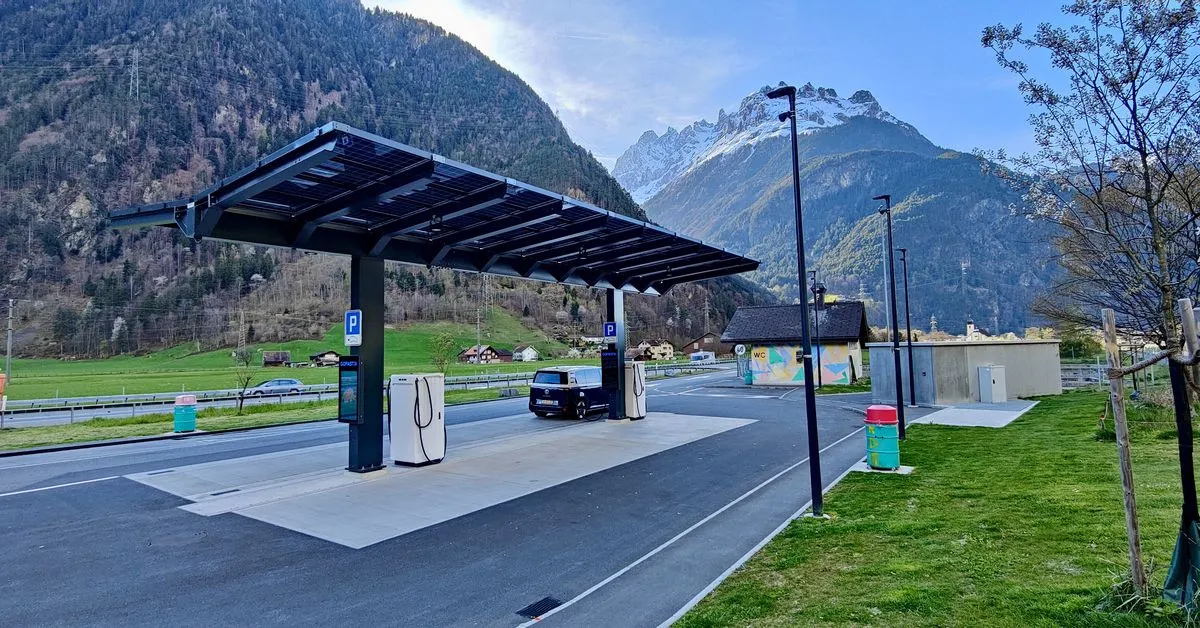Sometimes, I dream that at least half of the same effort was made for public transport between densely populated areas
Currently doing my first long trip (~450km) with my EV. Highway charging is more or less already pretty good between Germany and Austria. Faced some issues esp where a 150kw charger maxed out at 18kw somewhere in Austria , when I had only 80km to spare.
I’m a bit skeptical about it really working on large scales during summer holidays. Aren’t EV supposed to charge for at least 30 minutes 1 hour minimum to be able to get some autonomy? How is that realistic with such a high number of vehicles?
Our EV6 should be one of such newer models. We just did our first holiday trip with it from Belgium to Brittany. Some key points to note;
- it’s 20 minutes up to 80% on fast chargers. The remaining 20% is an additional 20 minutes
- sometimes there will be no free charger and other cars are NOT fast charging
- while the range was quoted being 480km it’s closed to 320 with a vehicle full for a 2weeks trip with and additional car roof luggage
- you also need charge at destination. Our last leg was on smaller roads with less chargers
In addition with 2 kids it makes sense anyway to pause for 30mins every 300km or so. For us ot was a pleasant experience all in all.
Interesting, thank you for your feedback! I guess my main concern is about having enough chargers to be able to charge all the vehicles at one. Having so many cars stuck for 20 minutes isn’t the same deal as filling them all in 5 minutes or so.
At least here in my region, most charging parks have somewhat between 10 and 40 chargers. Small stations 4 or 5.
I never had any issue finding an empty slot - the trick is to plan ahead a tiny bit and to have enough power left to drive to the next charger, worst case.Also, chargers post their status online, so my car knows ahead if there is a free slot - and can change the route accordingly.
I’d say that charger state and availability isn’t exactly up to date consistently at least in France and Belgium. We found a lot of degradations on even newer stations and sometimes we had to skip to the next one. You’re absolutely right that one needs to be cautious a out being able to reach an eventual next charging station.
Imho that needs to be ironed out before we can hope to convince the general population of the feasibility of the transition.
Yeah, right now, EV driving is 100% feasible on every route I have ever taken - but it takes a bit of effort and planning over long distance & unknown routes. So, fingers crossed the EV charging network will grow as promised.
I love my EV, wouldn’t go back to ICE ever - but I’m not sure that I would recommend my 70+ y/o parents an EV.
Thanks to apps like ABRP or, my app of choice, EVMap (+goggle maps for the navigation) it is easy to see the status (empty, full, defect) of a station way ahead - but if your expectation is just to drive like you did with an ICE, just go and if the car is empty start to look for a random fuel station - you might be annoyed pretty fast. Or you drive a Tesla, they do this pretty well without extra apps.Maybe the charge cost is the one thing I’d bitch about. It seems quite more expensive. So far my employer pays for it but it looks like I could easily exceed my yearly allowance. Which is a luxury not everyone has so thinking about those who pay for their fuel it might be the 2nd blocking point together with the cost of the vehicle itself.
But yeah I wholeheartedly agree that I don’t wanna go back to ICE. Even my wife who was fiercely against (for no fucking reason) is now stealing my car on any occasion.
Maybe the charge cost is the one thing I’d bitch about. It seems quite more expensive.
The only case where this is true is if you use DC-Fast charging all the time. AC charging is usually around 40ct/kWh in Germany, which with a modern EV with 16-20kWh/100km is between 6,40€ and 8€ per 100km. A bit more due to charging losses, but thats not that much on modern cars. 7-9€ is the maximum. 16-20kWh is for a car like an Kia EV6 though, which is a higher-end car. If you compare that to a similarly priced ICE car, e.g. an Mercedes C-Class which uses ~6.5l/100km, you pay 11,50€/100km with the current prices of 1,75€-1,80€ per liter. For your daily business where you only drive from home to the office it’s totally feasible to use AC-charging 99% of the time.
DC-Fast charging is more expensive with ~70ct per kWh, but only useful if you do long distance trips. On long distance your car needs more energy than in the city (due to regenerative braking not doing that much), so at least 14€/100km with 20kWh/100km, probably ~16€ realistically. Compare that to Autobahn gas stations with ~2,30/l-2,40€/l and you get 15€/100km for the C-Class though. So even then its not drastically more expensive, if you directly compare the prices which most people pay on long-distance trips.
HOWEVER! You can of course drive your gas car to gas stations a bit further away from the Autobahn and save quite a lot, filling up the car for the non-Autobahn gas prices again. Thats not possible with EV fast charging, since DC-Fast charging costs the same everywhere.
HOWEVER AGAIN! If you don’t drive long distances regularly, which most people don’t do, you will save a significant amount of money since charging is cheaper than gas.
so… certain countries in Europe do trains AND EV charging better than the US - love that
Yeah I wondered about the current throughput of a gas station and how would the charging time affect road congestion even given full charger availability. Also the room needed for stations will likely be much larger to account for the increased parking time during charge.
An interesting side effect would be that drivers would have forced breaks from driving, potentially resulting in less crashes due to attention exhaustion.
We have a Tesla Model 3 since 4 years, did 90K km.
Exactly same experience here, we travelled across France several times and never had issues regarding charging or battery anxiety.
As we also have kids, we stop every ~2h30 and charge during that time.
France is nice for that. Also for their food but that’s unrelated 😅
In Belgium the stupid ass decision to give tax credit to companies that installed chargers is resulting in an over abundance of slow chargers that can hardly be used while charging stations are less plentiful. It’s bugging me to no end 😩
Belgium and tax credit, name a more iconic duo (I grew up in Belgium)
Don’t even need kids - I tend to get very sleepy after 2-3 hours of driving anyway, so getting to take a little walk for 15-30 minutes is way healthier than loading up on energy drinks / coffee in a five minute stop.
Newer ones can charge an acceptable amount in 10 to 15 minutes. Technology is rapidly improving, and will only get better. Also if there’s lots of chargers along multiple rest stops, shouldn’t be a problem to find one.
Bigger problem is the clusterfuck of roaming agreements, apps, charge cards, and obscure rules between all these charger operators. Also how to find the chargers and their status. Needs to be regulated into an open standard.
It’s not as complicated as I thought at first. Driving a Tesla you have most routes covered with Tesla Superchargers.
Additionally, I have a basic subscription from an electricity provider including their charging card for rare cases where the app doesn’t work. There are just 3 different types with increasing rates:
- Owned by provider
- Not owned by provider
- Ionity
Yes but that depends on the car and country. I have a 2019 Nissan Leaf. Don’t have access to any manufacturer specials or anything.
In the perfect world in the future, any EV will be able to plug in to any charger, automatically authenticate, and have a clear price display, and that info would be easily findable in a central place.
I’m on vacation with a rented Tesla Y LR in Tuscany right now. We traveled all the way from northern Germany (about 1500 km) and never had any issues finding a free charging station. Just once every single parking spot was used and the charging automatically stopped at 80% in order to make space for others more quickly (and to be honest, this was due to other cars parking in the Tesla reserved parking spots at an Italian supermarket).
Traveling with kids automatically makes you take a break every 3 hours or so. This time, we just let the car charge during these breaks and had a 100% charged car afterwards. That’s about 55 min of charging time. In about 25 min you can charge from 20% to 80% using a 250 kW supercharger.
You have to keep in mind that long distance travel is not the usual use case and that being able to slowly charge the vehicle during the night is also important. Most camping sites, hotels and vacation resorts offer at least two 11 kW stations at their own rates.
right now
That’s the key phrase. Consider a regular gas station where cars constantly come and go. Now, imagine if in 10 years we’ll have a similar demand for EV charging stations. I can’t see that working well with the current batteries. Solid-state batteries are not available yet and there’s no guarantee that they’ll hit the market anytime soon.
You realize you can put “electricity pumps” in any retail parking spot, right?
Putting in a gas station is a horrifyingly complex infastructure demand. Slapping 2-4 chargers in literally every retail parking lot is simple in comparison.
No, you can’t. Adding a large number of EV chargers requires a significant upgrade to the electrical grid. This is a massive infrastructure challenge. Charging an electric vehicle consumes a large amount of electricity, and the current electrical grid may not be equipped to handle a significant increase in demand. This could lead to overloads and blackouts.
Unlike refueling a car with gasoline, charging an electric vehicle takes a significant amount of time. Even with fast chargers, a full charge can take more than an hour. This would mean that you wouldn’t be able to put nearest gas station in your Waze, you might need to cruise around an unknown city, looking for a free spot.
The cost of installing EV charging stations is significant, and it’s not clear who should bear this cost. Should it be the government, property owners, or the consumers? Additionally, the maintenance and repair of these charging stations are not negligible.
If the electricity used to charge the vehicles is not generated from renewable sources, then the overall environmental impact could still be significant as well as impact on the electricity prices.
There is a lot one should consider before writing witty replies.
A lot of generalization and supposition in the above.
Adding charging stations may require grid upgrades, but its a slow and steady requirement you can do neighborhood by neighborhood. Depending on the neighborhood, it may not be required, be minor, or be massive. It all depends. Making sweeping generalization about power generation, a deeply localized utilty, is a poor choice.
In my locality and most of my state, a large amount of charging spots are going up in front of common retailers with no clear utilty work. Our grid is currently fully able to bear the added load.
As to who pays for it, the current system seems to work, and will only improve as more cars go electric. The most effective method seems to be a mesh of private/public investment. Public for grid sizing, power supply and sometimes space for the charger. Private cost of wholesale power, charger install and maintenance, interoperability and paymebt processing. The Private entity takes the gross profits in the above, paying for power and any split with other private entities. The public has its costs covered and has a net positive public good added.
It is not that complicated to install charging infastructure 2 chargers at a time. It seems pretty apparent that retail spaces at least in the US are over built powerwise, and can largely handle the addition. Its why many grocery stores have them popping up suddenly in urban areas.
As to the cleanliness of energy, one large pollution provider is overall more environmentally friendly than millions of small ones. They can also be regulated and inspected in a way millions of small ones cannot be. Centralized generation of power for cars via electricity, of any source, will be greener than millions of cars burning gasoline. Always. Shifting the load to renewables as well is the right answer, but any shift here is good.
Stop saying this is a “massive infastructure challenge” when its actually a small and steady challenge occuring thousands of times. Small things done over and is the massive part, and they are very doable today, in the US and the EU.
Thanks for your feedback! I’m just curious how it would be realistic to scale the charging stations enough to sustain a larger (let’s say 30% or even 50%) of cars being EV. Should we just have giant charging stations hubs every 50 km?
You have to keep in mind that long distance travel is not the usual use case and that being able to slowly charge the vehicle during the night is also important.
That’s very true, to be honest my personal preference would be to reassess the need to have so many people travelling so much during July/August (you see the most popular hotspots such as Venise or Barcelona trying to reduce the number of tourists) but that’s a different story
The key is that you put charging next to other amenities like restaurants and rest stops.
You should never really be stopping only to charge your car, you should be charging while stopping to do other things.
This makes sense, but for every parking spot at restaurants and rest stops parking to have a charger seems like quite a logistical challenge.
I have a wall charger at my Airbnb for a year now, with plenty of drive thru stays from Sweden, Norway an Holland to Italy, Croatia and back. I have yet have a guest need or use it. 🤷
There needs to be more around before people feel more comfortable with going full EV
Does anyone know what the status is on the electryfying roads in Europe? Like they’ll do in Sweden (permanent electric road
patented technology […] transmits up to 300kW of power to the vehicle through a retractable pick-up that drags along a metal rail embedded in the road.
Interesting. So that would be one lane on only?
One of the biggest issue right now is diversification. If we (try to) establish various different loading technologies will we only be able to use one in some places? Will we be able to use and need various adapters? Will we have to adjust our vehicles eventually with a tech switch?
We’re still in a diversification stage. Hopefully we’ll arrive in a consolidation phase soon, or a more structured focused international approach.
We’re still in a diversification stage. Hopefully we’ll arrive in a consolidation phase soon, or a more structured focused international approach.
We shall see which system will come out best, maybe several. I do like the electryfying road for charge up
I’m not an expert or anything, but my masters was focused on driving technology, and specifically the intersection of technology and sociology. A conclusion I often felt drawn to is that, while humans are still the drivers, the technology will always lack efficiency.
Charging highway is a neat idea but having it shared between vehicles like trucks which try to travel a consistent speed, and cars which change lanes etc, means that I think the human factor will complicate the process (and safety) to a high degree.
There are a great many advancements we can make to automotive technology if we reduce our reliance on a human driver.
For sure, the human/ machine interface is leading. Sometimes humans adapt, and at other times it’s the machine that needs to change. Especially in these cases the question is what or who defines efficiency. Some might say (human) need, comfort & accessibility.












